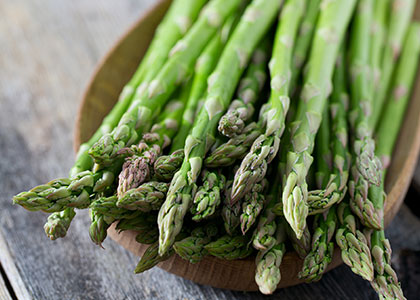
What to Eat this Spring
By Isabel Smith, MS, RD, CDN
It’s finally feeling like spring here in New York! The sun is shining, New Yorkers are starting to come out of hibernation, and farm-fresh vegetables and fruits are starting to appear at the local farmers’ market. As we welcome in spring we also welcome in some seasonal produce that grows locally during the months of March, April and May. Here are a few of my favorite spring fruits and vegetables that I’ll be stocking in my pantry this spring, and you should too!
8 Seasonal Fruits and Vegetables to stock in your pantry this spring:
1. Asparagus
I just love asparagus — pPurple and white varieties as well as green varieties! This green skiiny veggie is extremely versatile and packed with nutrients. Asparagus is a high source of vitamins A, C, E, K and B, and folate that plays a role in red bood cell formation. It’s s also a source of glutathione, a nutrient that contains natural detoxifying properties and can help to break down carcinogens in the body.
How to use asparagus: You can bake, roast, sauté, grill or steam asparagus. You can also juice it! I personally love to use it in a stir fry with other like-vegetables.
Aspragus Recipes:
2. Swiss Chard
Swiss chard is also a favorite and staple in my kitchen. Chard is loaded with hydrating electrolytes like sodium, potassium and magnesium, and it’s also a source of vitamin B-6, iron and calcium. Swiss chard also contains manganese, a compound that plays an important role in the formation of superoxide dismutase that acts as an antioxidant in the body. Finally, chard makes a good replacement for anyone with hypothyroid or who needs to be cautious with raw, goitrogenic vegetable intake.
How to use Swiss chard: I love to use chard in juices or smoothies; you can also use it in entrees, as a side or in soup.
Swiss Chard Recipes:
3. Radicchio
Radicchio is another in-season vegetable for spring. Radicchio is beautiful to look at, and is also loaded with nutrients including anthocyanin that is a powerful anti-inflammatory compound. Radicchio is a source of vitamins A, B, C, and K, and also a source of antioxidants leutein and zeaxanthin that can help promote eye health and prevent macular degeneration.
How to use radicchio: Radicchio can be used in juices, smoothies and as part of salads.
Radicchio Recipe:
4. Red Leaf Lettuce
Red leaf lettuce is another non-goitrogenic green (good for anyone with hypothyroid) and seasonal vegetable. I love red leaf lettuce because it’s light, fresh and goes great with avocado in a salad or even as part of a juice or smoothie because it doesn’t have a strong taste. Red leaf lettuce is a source of anti-inflammatory anthocyanin as well as vitamins, A, B1, B2, B6 and K.
How to use red leaf lettuce: It’s light and can be used for a delicious sandwich or salad or even in juices and smoothies.
Red Leaf Lettuce Recipe:
5. Pineapple
Pineapple is packed with heart-healthy electrolyte, potassium as well as bromelain, a potent anti-inflammatory nutrient. Aside from being packed with nutrients, pineapple is also a fun and delicious addition to juices, smoothies, salads, breakfast cereal and more.
How to use pineapple: I recommend using pineapple in both juices and smoothies, but like any other fruit, it’s a good idea to moderate the amount you use to prevent consuming too much sugar.
Pineapple Recipes:
6. Broccoli
Broccoli is great in juices, raw for snack, blended in smoothies, and steamed or roasted as as part of an entrée. Broccoli is a cruciferous vegetable that is loaded with anti-cancer and detoxifying nutrients like isothiocyanates and sulforaphanes. Broccoli is also a source of calcium, iron, vitamins A and C, fiber and also contains a small amount of protein.
How to use broccoli: Use broccoli in many different ways both raw and cooked, including in smoothies, juices, and as part of entrees and even soups.
Broccoli Recipes:
7. Fennel
Fennel has a fresh and crisp taste and a semi-licorice flavor. I love adding it sliced thin to salads! Fennel contains nutrients like zinc that helps promote wound healing, manganese that acts as part of the antioxidant superoxide dismutaste, and vitamin C.
How to use fennel: Use fennel raw in a juice or salad, or cooked as part of a stir fry or vegetable roast.
Fennel Recipes:
8. Strawberries
Strawberries aren’t only so delicious and juicy but they’re loaded with nutrients including immune-boosting vitamin C, heart-healthy potassium and nutrients like flavonoids and ellagic acid that act as antioxidants in the body.
How to use strawberries: Use them in smoothies, juices, salads, or simply on their own.
Strawberry Recipes: